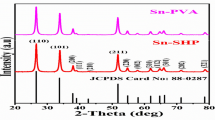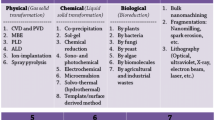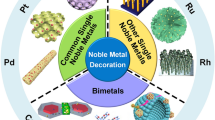Abstract
Detection of volatile organic compounds (VOCs) is rapidly becoming a necessity as they have significant percentage in the indoor air pollution. Therefore, use of highly sensitive, small and portable VOC sensors ranges from households, offices to large industries. This paper deals with the use of a highly responsive semiconductor, i.e. SnO2, in VOC sensors. A hitherto unreported strategy of using hollow cage-frame-type nanostructures is proposed. These hollow particles supersede the response characteristics of solid or even the porous nanostructures, which are mostly used till date. VOCs such as: ethanol, methanol, acetone, toluene and formaldehyde can be easily detected using SnO2 hollow structures as the chemically active component of the sensor. The fabricated sensors exhibit high selectivity for each VOCs, at different operating temperature. The sensing mechanism of hollow nanostructures is also described in detail. The work can initiate significant activity on VOC sensing using hollow structures, which has remained ignored till now.








Similar content being viewed by others
References
Toxicological profile for acetone - U.S. Department of health and human services public health service agency for toxic substances and disease registry, 1994
Zakharov S, Kotikova K, Vaneckova M, Seidl Z, Nurieva O, Navratil T, Caganova B, Pelclova D (2016) Acute methanol poisoning: prevalence and predisposing factors of haemorrhagic and non-haemorrhagic brain lesions. Basic Clin Pharmacol Toxicol 119:228–238
Ahmed FE (1995) Toxicological effects of ethanol on human health. Crit Rev Toxicol 25:347–367
Kandyala R, Raghavendra SPJ, Rajasekharan ST (2010) Xylene: An overview of its health hazards and preventive measures. J Oral Maxillofac Pathol 14:1–5
Lu R, Li WW, Mizaikoff B, Katzir A, Raichlin Y, Sheng GP, Yu HQ (2016) High-sensitivity infrared attenuated total reflectance sensors for in situ multicomponent detection of volatile organic compounds in water. Nat Protoc 11:377–386
Mirzaei A, Leonardi SG, Neri G (2016) Detection of hazardous volatile organic compounds (VOCs) by metal oxide nanostructures-based gas sensors: a review. Ceram Int 42:15119–15141
Dey S, Santra S, Ray SK, Guha PK (2018) Temperature tunable selectivity of NiO/FexNi(1–x)O heterojunction device based VOC sensor. IEEE Sens 20:1–4
Zeng Q, Cui Y, Zhu L, Yao Y (2020) Increasing oxygen vacancies at room temperature in SnO2 for enhancing ethanol gas sensing. Mater Sci Semicond Process 111:104962
Zito CA, Perfecto TM, Volanti DP (2018) Porous CeO2 nanospheres for room temperature triethylamine sensor under high humidity condition. New J Chem 42:15954–15961
Dutt M, Ratan A, Tomar M, Gupta V, Singh V (2020) Mesoporous metal oxide–α-Fe2O3 nanocomposites for sensing formaldehyde and ethanol at room temperature. J Phys Chem Solids 145:109536
Seo M-H, Yuasa M, Kida T, Huh J-S, Yamazoe N, Shimanoe K (2010) Microstructure control of TiO2 nanotubular films for improved VOC sensing. Sens Actuators B Chem 154:251–256
Acharyya S, Jana B, Nag S, Saha G, Guha PK (2020) Single resistive sensor for selective detection of multiple VOCs employing SnO2 hollowspheres and machine learning algorithm: a proof of concept. Sens Actuators B Chem 321:128484
Li B, Zhou Q, Peng S, Liao Y (2020) Recent advances of SnO2-based sensors for detecting volatile organic compounds. Front Chem 8:321
Fischer T, Singh AP, Singh T, Ramírez FH, Prades D, Mathur S (2013) Metal oxide nano-architectures and heterostructures for chemical sensors, book chapter metal oxide nanomaterials for chemical sensors. Springer, New York, pp 397–438
Srivastava AK (2003) Detection of volatile organic compounds (VOCs) using SnO2 gas-sensor array and artificial neural network. Sens Actuators B Chem 96:24–37
Sakai Y, Kadosaki M, Matsubara I, Itoh T (2009) Preparation of total VOC sensor with sensor-response stability for humidity by noble metal addition to SnO2. J Ceram Soc Jpn 117:1297–1301
Wei B (2004) A novel SnO2 gas sensor doped with carbon nanotubes operating at room temperature. Sens Actuators B Chem 101:81–89
Govender M, Mwakikunga BW, Mathur S, Singh T, Kaouk A, Gönüllü A, Machatine AGJ, Kunert HW (2014) Selective room-temperature sensing of NO2 by WO3 film/graphene layers. In: Sensors IEEE, vol 2014, pp 301–314
Singh I, Dey S, Santra S, Landfester K, Munoz-Espí R, Chandra A (2018) Cerium-Doped copper (II) oxide hollow nanostructures as efficient and tunable sensors for volatile organic compounds. ACS Omega 3:5029–5037
Xing X, Yang Y, Yan Z, Hu Y, Zou T, Wang Z, Wang Y (2019) CdO-Ag-ZnO nanocomposites with hierarchically porous structure for effective VOCs gas-sensing properties. Ceram Int 45:5029–5037
Park KR, Cho H-B, Lee J, Song Y, Kim W-B, Choa Y-H (2019) Design of highly porous SnO2-CuO nanotubes for enhancing H2S gas sensor performance. Chemical, Sensors and Actuators B, p 127179
Kim H-J, Lee J-H (2014) Highly sensitive and selective gas sensors using p-type oxide semiconductors: overview. Sens Actuators B Chem 192:607–627
Chiu HC, Yeh CS (2007) Hydrothermal synthesis of SnO2 nanoparticles and their gas-sensing of alcohol. J Phys Chem C 111:7256–7259
Wang Y, Mu Q, Wang G, Zhou Z (2010) Sensing characterization to NH3 of nanocrystalline Sb-doped SnO2 synthesized by a nonaqueous sol–gel route. Sens Actuators B Chem 145:847–853
Nayak AK, Ghosh R, Santra S, Guha PK, Pradhan D (2015) Hierarchical nanostructured WO3–SnO2 for selective sensing of volatile organic compounds. Nanoscale 7:12460–12473
Lei J, Zhang Q, Zhao Z, Chen Y, Gao J, Tong J, Xiao H (2020) One step fabrication of nanocrystalline nanonetwork SnO2 gas sensors by integrated multilaser processing. Adv Mater Technol 5:2000281
Biswas S, Chowdhury A, Chandra A (2019) Performance of Na-ion supercapacitors under non-ambient conditions – from temperature to magnetic field dependent variation in specific capacitance. Front Mater 6:54–64
Biswas S, Sharma V, Mandal D, Chowdhury A, Chakravarty M, Priya S, Gowda CC, De P, Singh I, Chandra A (2020) Hollow nanostructures of metal oxides as emerging electrode materials for high performance supercapacitors. Cryst Eng Comm 22:1633–1644
Mwakikunga B, Singh T, Irina G, Fischer T, Lepcha A, Eiddin GE, Faglia G, Mathur S (2013) Development of single-few-and multiple nanowires gas-sensor two terminal device on ceramic substrates and characterization by impedance spectroscopy. In: Nanostructured Materials and Nanotechnology VII: Ceramic Engineering and Science Proceedings, vol 34, pp 149–156
Ren P, Wang Z, Liu B, Lu Y, Jin Z, Zhang L, Li L, Li X, Wang C (2020) Highly dispersible hollow nanospheres organized by ultra-small ZnFe2O4 subunits with enhanced lithium storage properties. J Alloy Compd 812:152014
Sivashanmugam A, Kumar TP, Renganathan NG, Gopukumar S, Wohlfahrt-Mehrens M, Garche., J., (2005) Electrochemical behavior of Sn/SnO2 mixtures for use as anode in lithium rechargeable batteries. J Power Sources 144:197–203
Mwakikunga BW, Ray SS, Mokwena M, Dewar J, Geibelhaus I, Singh T, Fischer T, Mathur S (2013) Tin dioxide nano-wire device for sensing kinetics of acetone and ethanol towards diabetes monitoring. In: Sensors IEEE, vol 2013, pp 1–4
Chowdhury A, Dhar A, Biswas S, Sharma V, Burada PS, Chandra A (2020) Theoretical model for magnetic supercapacitors—From the electrode material to electrolyte ion dependence. J Phys Chem C 124:26613–26624
Mandal D, Khatun S, Gupta AN, Chandra A (2019) DNA supported graphene quantum dots for Ag ion sensing. Nanotechnology 30(25):255501
Zhang K, Yang X, Wang Y, Bing Y, Qiao L, Liang Z, Zheng W (2017) Pd-loaded SnO2 ultrathin nanorod-assembled hollow microspheres with the significant improvement for toluene detection. Sens Actuators B Chem 243:465–474
Ying Z, Wan Q, Song ZT, Feng SL (2004) SnO2 nanowhiskers and their ethanol sensing characteristics. Nanotechnology 15:1682–1684
Zhao YF, Sun YP, Yin X, Yin G-C, Wang XM, Jia FC, Liu B (2018) Effect of surfactants on the microstructures of hierarchical SnO2 blooming nanoflowers and their gas-sensing properties. Nanoscale Res Lett 13:250
Kumar N, Rosy, and Goyal R. N. (2017) Gold-palladium nanoparticles aided electrochemically reduced graphene oxide sensor for the simultaneous estimation of lomefloxacin and amoxicillin. Sens Actuators B Chem 243:658–668
Abideen ZU, Kim JH, Kim SS (2017) Optimization of metal nanoparticle amount on SnO2 nanowires to achieve superior gas sensing properties. Sens Actuators B Chem 238:374–380
Mandal D, Biswas S, Chowdhury A, De D, Tiwary CS, Gupta AN, Singh T, Chandra A (2020) Hierarchical cage-frame type nanostructure of CeO2 for bio sensing applications: from glucose to protein detection. Nanotechnology 32(2):025504
Author information
Authors and Affiliations
Corresponding authors
Additional information
Handling Editor: Joshua Tong.
Publisher's Note
Springer Nature remains neutral with regard to jurisdictional claims in published maps and institutional affiliations.
Supplementary Information
Below is the link to the electronic supplementary material.
Rights and permissions
About this article
Cite this article
Priya, S., Halder, J., Mandal, D. et al. Hierarchical SnO2 nanostructures for potential VOC sensor. J Mater Sci 56, 9883–9893 (2021). https://doi.org/10.1007/s10853-021-05942-x
Received:
Accepted:
Published:
Issue Date:
DOI: https://doi.org/10.1007/s10853-021-05942-x




